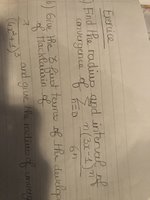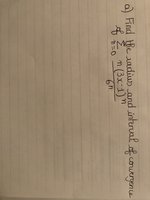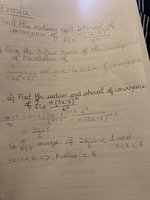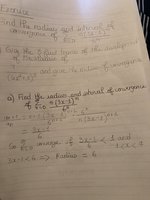You are using an out of date browser. It may not display this or other websites correctly.
You should upgrade or use an alternative browser.
You should upgrade or use an alternative browser.
Calculus II
- Thread starter Marie1309
- Start date
- Joined
- Nov 24, 2012
- Messages
- 3,021
I suspect the issue is that the images are sideways, and not with your handwriting, which is actually very nice. If you're uploading images from a phone, then it's not really your fault...I see a lot of sideways images on forums from mobile users. Is this the question?
a) Find the radius and interval of convergence of:
\[\sum_{n=0}^{\infty}\frac{n(3x-1)^n}{6^n}\]
a) Find the radius and interval of convergence of:
\[\sum_{n=0}^{\infty}\frac{n(3x-1)^n}{6^n}\]
HallsofIvy
Elite Member
- Joined
- Jan 27, 2012
- Messages
- 7,760
Then use the "limit ratio test": \(\displaystyle \sum a_n\) converges absolutely if \(\displaystyle \lim \left|\frac{a_{n+1}}{a_n}\right|< 1\).
Yes that’s correct this is how I started but I’m not sure if it is correctI suspect the issue is that the images are sideways, and not with your handwriting, which is actually very nice. If you're uploading images from a phone, then it's not really your fault...I see a lot of sideways images on forums from mobile users. Is this the question?
a) Find the radius and interval of convergence of:
\[\sum_{n=0}^{\infty}\frac{n(3x-1)^n}{6^n}\]
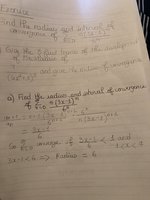
Last edited by a moderator:
I did but I’m not sure if it is correctThen use the "limit ratio test": \(\displaystyle \sum a_n\) converges absolutely if \(\displaystyle \lim \left|\frac{a_{n+1}}{a_n}\right|< 1\).
Attachments
- Joined
- Nov 24, 2012
- Messages
- 3,021
What we want is:
[MATH]\frac{|3x-1|}{6}<1[/MATH]
or:
[MATH]\left|x-\frac{1}{3}\right|<2[/MATH]
And so the radius of convergence is 2, and the interval of convergence is:
[MATH]\left(\frac{1}{3}-2,\frac{1}{3}+2\right)[/MATH]
or:
[MATH]\left(-\frac{5}{3},\frac{7}{3}\right)[/MATH]
Steven G
Elite Member
- Joined
- Dec 30, 2014
- Messages
- 14,603
Your work is very sloppy. When you replace n with n+1 you must write (n+1). The powers of (3x-1) are both n+1in your work. But this can't be since in one case n stays n and in the other case n becomes (n+1). You were told to take lim |{an+1/an|<1, yet you did not take the absolute value nor did you write limit. Also how did you compute that the radius of convergence is 6?
I think I got it now. So IS The radius of convergence 2?Your work is very sloppy. When you replace n with n+1 you must write (n+1). The powers of (3x-1) are both n+1in your work. But this can't be since in one case n stays n and in the other case n becomes (n+1). You were told to take lim |{an+1/an|<1, yet you did not take the absolute value nor did you write limit. Also how did you compute that the radius of convergence is 6?
Hello, Thank you so much for your help and I did not understand how did you find the radius equals to 2?What we want is:
[MATH]\frac{|3x-1|}{6}<1[/MATH]
or:
[MATH]\left|x-\frac{1}{3}\right|<2[/MATH]
And so the radius of convergence is 2, and the interval of convergence is:
[MATH]\left(\frac{1}{3}-2,\frac{1}{3}+2\right)[/MATH]
or:
[MATH]\left(-\frac{5}{3},\frac{7}{3}\right)[/MATH]
MathProfessor
New member
- Joined
- Mar 22, 2019
- Messages
- 4
If a power series converges for |x-a|<R and diverges for |x-a|>R, then the power series is centred at point a and has radius r=R. In your case a=1/3 and R=2. The interval of convergence is (a-R, a+R) = (-5/3,7/3) . The series diverges for both x=-5/3 and x=7/3 so the interval is open.
Last edited:
- Joined
- Nov 24, 2012
- Messages
- 3,021
Hello, Thank you so much for your help and I did not understand how did you find the radius equals to 2?
We have:
[MATH]\frac{|3x-1|}{6}<1[/MATH]
And we want to get this in the form:
[MATH]|x-a[<r[/MATH]
And so we factor out a 3 from the numerator and divide out common factors to get:
[MATH]\frac{\left|x-\dfrac{1}{3}\right|}{2}<1[/MATH]
Multiply through by 2:
[MATH]\left|x-\frac{1}{3}\right|<2[/MATH]
And so we have it in the form we want, where \(\dfrac{1}{3}\) is the center of the interval of convergence, whose radius is \(2\).
Does that make sense?
RIGHTTT. Makes a lot of sense. Thank you so much for your time.We have:
[MATH]\frac{|3x-1|}{6}<1[/MATH]
And we want to get this in the form:
[MATH]|x-a[<r[/MATH]
And so we factor out a 3 from the numerator and divide out common factors to get:
[MATH]\frac{\left|x-\dfrac{1}{3}\right|}{2}<1[/MATH]
Multiply through by 2:
[MATH]\left|x-\frac{1}{3}\right|<2[/MATH]
And so we have it in the form we want, where \(\dfrac{1}{3}\) is the center of the interval of convergence, whose radius is \(2\).
Does that make sense?
Hey. Thanks for helping. But may I know why it diverges for both? . ThanksIf a power series converges for |x-a|<R and diverges for |x-a|>R, then the power series is centred at point a and has radius r=R. In your case a=1/3 and R=2. The interval of convergence is (a-R, a+R) = (-5/3,7/3) . The series diverges for both x=-5/3 and x=7/3 so the interval is open.
- Joined
- Nov 24, 2012
- Messages
- 3,021
Hey. Thanks for helping. But may I know why it diverges for both? . Thanks
When we use the ratio test, we find the limit:
[MATH]L=\lim_{n\to\infty}\left|\frac{a_{n+1}}{a_n}\right|[/MATH]
The ratio test states that:
- if \(L<1\) then the series converges absolutely;
- if \(L>1\) then the series is divergent;
- if \(L=1\) or the limit fails to exist, then the test is inconclusive, because there exist both convergent and divergent series that satisfy this case.
Last edited by a moderator:
MathProfessor
New member
- Joined
- Mar 22, 2019
- Messages
- 4
When [MATH]x=\frac{7}{3}[/MATH] you have L=1 which is the case when the ratio test does not allow to conclude. In this case you replace xHey. Thanks for helping. But may I know why it diverges for both? . Thanks
by [MATH]\frac{7}{3}[/MATH] in [MATH]a_n[/MATH] and use the divergence test. Use the same step for [MATH]x=\frac{-5}{3}[/MATH]. The interval of convergence is the set of points where the series converges.
Last edited:

